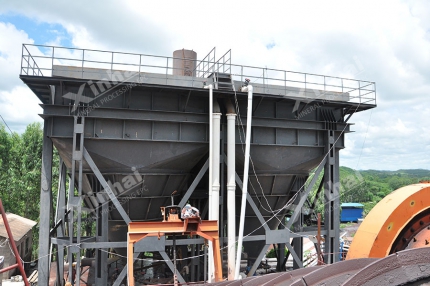Normal thickeners, sediment towers, and coal slurry pools are widely used in China old-type coal preparation plants. This equipment has lots of problems, including low sedimentation efficiency, large sedimentation area, high capital construction investment and environmental pollutions. However, high-efficiency slant tube can overcome these disadvantages to a large extent by increasing settlement area within limited spaces, shortening particles sedimentation distance and creating a sound laminar settling environment.

Graph 1
As shown in graph 1, for a slurry with the same concentration, test tube A is positioned upright, its deposit area is restricted to the circular cross-section area; while test tube B is placed at an angle, its deposit area is bigger than that of test tube A with no doubt. The precipitation distance of liquid surface particles in test tube A is H. While in test tube B, the particles first settle on the tube wall and then slide along with the tube wall under their own gravity, finally reach the tube’s bottom, during which the precipitation distance is H1. We can notice from the graph that H1 is smaller than H, making deposition efficiency of inclined-placed tube higher than that of the uptight tube A. High-efficiency slant-tube thickeners just make use of this principle to meet the target of increasing settlement area and sedimentation efficiency.

Graph 2
As shown in graph 2, there are two adjacent inclined plates in high-efficiency slant-tube thickeners. In thickeners, particles make vertical downward movement because of their own gravity. The downward speed V can be decomposed into two components, Vsinα parallel to the inclined plate and Vcosα perpendicular to the inclined plate. Particles approach and settle onto the inclined plate at speed Vcosα, and then make downward movement along the plate under gravity till they arrive at the inclined plate’s bottom to finish the sedimentation process. From the graph we know that particles longest sedimentation distance S is shorter than the inclined plate’s length L, contributing to the increase of settling efficiency. Besides, hydraulic radius of slant tube decreases a great deal. According to Re=vR/r, when Reynolds number Re becomes smaller, the fluid becomes closer to laminar flow, providing favorable conditions for increasing rising water flow velocity.
The particles settling down to the bottom will gather to the center from the cone angle and then are transmitted to the next segment operation by pumps. While the classified water will rise continuously, finally entering the spillway trough and then coming back to circulating water system.


 marketing@ytxinhai.com
marketing@ytxinhai.com  0086 13810327080
0086 13810327080 






































































































 CHAT
CHAT MESSAGE
MESSAGE



